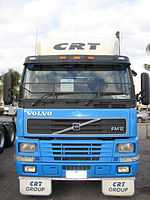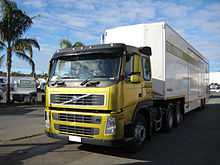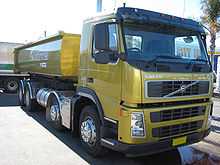Volvo FM
| Volvo FM series | |
|---|---|
 | |
| Overview | |
| Manufacturer | Volvo Trucks Corporation |
| Production | 1998-present |
| Assembly |
Gothenburg, Sweden Ghent, Belgium Brisbane, Australia Durban, South Africa Bangalore, India Curitiba, Brazil Cairo, Egypt (Ghabbour Group)[1] |
| Body and chassis | |
| Class | Heavy truck |
| Body style |
|
| Related | FH |
| Powertrain | |
| Engine |
Inline 6-cylinder turbo-charged & intercooled
|
| Transmission |
|
| Chronology | |
| Predecessor | FL7,FL10 and FL12 series |
The Volvo FM is a heavy truck range produced by Swedish Volvo Truck Corporation. Introduced in 1998 as FM7, FM10 and FM12 production continues with the second generation of FM range. FM stands for Flat Medium height cab, where the numbers denominate an engine capacity in litres. As of 2005 the engine size is no longer added to the model denomination. The FM range is a multipurpose truck range for distribution, construction and on highway/off highway transport duties.[2] In 2013, Volvo Trucks announced an updated, Euro 6 version of the Volvo FM.[3]
Introduction
The FM introduction continued to build on successful line of F7, FL7 and FL10 trucks and it was also a part of Volvo Trucks Corporation planning strategy for "The Global Family Of Trucks"[4] where FM would be complementing FH and NH/VN truck range. Released in conjunction with face-lifted FH range the FM7,10,12 included Volvo electronic architecture and upgraded D12 engine whilst carrying over the older D7 and D10 engines which traced their origins to the early push-rods TD70 and TD100 power plants but with modern electronic controls implants to increase power outputs and improve fuel efficiency and emissions.
Design and technology
The FM range is closely related to the FH range where models share the numbers of components further decreasing production and development costs while improving built efficiency and quality of the products. In principle the FM and the FH and to a degree the NH cabs have a same layout with driver and passenger area, dashboard and seats as the common feature. The lower position of FM cabs is the primary difference between the FM and FH ranges

First-generation (1998–2001)
Cabs
What appeared to be scaled down FH cabs were initially available in three basic sizes, short day cab,sleeper cab, and globetrotter cab. Various trims and color option were available. Electric cab tilt was an option.
Electric and electronics
The electrical and electronic system shared with the FH series was based on electronic control units and data bus technology. The communication among the different control units run via two data links SAE J1939 and SAE J1708 allowed possibility of diagnostics, analysis and follow up of the vehicle's system via instrument cluster display.
Engines
Engines horsepower rating span from 250 hp (190 kW) to 420 hp (310 kW) in the initial release.
- D7C -> 250-290 hp
- D10B -> 320-360 hp
- D12C -> 380-420 hp
D7C is a further development of D7 generation of engines however major difference between the latter is the increase of engine capacity from 6.7 litres to 7.3 litres thanks to increase in stroke and cylinder diameter. Engine management EDC also received the upgrade to bring it inline with the rest of the "family" and be TEA 98 compliant. Introduction of D12C engine had created all new beast in its class thanks to its extra power and powerful engine brake which were only available previously in the FH class saw operators with an option of smaller cab but still capable long haul unit particularly with globetrotter cab and indeed FM12 did steal some sales from its bigger brother the FH12.
Driveline
The FM7, FM10 and FM12 were available in variety of configurations with manual and automatic transmissions as 4x2 and 6x4 tractor and rigid, 8x2 and 8x4 rigid and 6x6 special construction models with hub reductions or single final drives.

Second generation (2001–present)
In 2001 FM series underwent major revision in conjunction with FH series.[5] Among changes resulted were 7- and 10-litre engines being dropped and replaced by an all-new 9-litre D9A engine and introduction of a new automated gear-change transmission I-shift and new passive safety feature FUPS Front Underrun Protection System, designed to prevent smaller vehicles from being "under run" or wedged under front of the truck in an event of frontal collision.
Engine and transmission
The new D9A engine developed on the basis of D12 with single overhead camshaft and four valves per cylinder and electronic unit injectors followed with a new design feature for Volvo, timing gears at the flywheel side (rear) of the engine, design which will later become standard across entire Volvo truck engine range. D9A power output varies from 300 - 380 hp (280 kW) and torque 1400 - 1700 Nm respectively. Introduction of I-shift also spelled end for Geartronic (AGS) and its shortcomings however the I-shift was designed to be what it is from ground up where Geartronic was an add on modification to existing manual transmission. In 2003 FM12 with 460 hp (340 kW) D12D was launched as well as new version of Powertronic automatic transmission.[6] L
2005 upgrade to present




The evolution of Volvo FM series continued in 2005 [7] with the release of a new generation of FM trucks powered by an all-new 13-litre D13A engine and improved 9-litre D9B unit and the second-generation I-shift transmission.[8] The naming of the series had also changed: engine size in litres is no longer used in the FM name. The new engines were available in Euro4 emissions standard in both Selective Catalytic Reduction. Volvo had also introduced on D13A engine with SCR an improved version of its engine compression brake the "VEB+" featuring additional helper rocker arm and fourth cam lobe per cylinder. Power outputs available from 360 hp (270 kW), 400 hp (300 kW), 440 hp (330 kW) and 480 hp (360 kW). In 2007 Volvo introduced D13B [9] with Exhaust Gas Recirculation configuration and VGT turbocharger but without exhaust particle filter and is the only manufacturer to offer this solution thus far. The engines are available in slightly reduced power output ranging from 360 hp (270 kW), 400 hp (300 kW), 440 hp (330 kW) and 500 hp (370 kW) however 500 hp (370 kW) option is only available for FH series.
Volvo Truck Corporation had announced[10] a new version of an engine the D11B available in two power outputs 390 hp (290 kW) and 430 hp (320 kW) as well as new safety features such as Driver Alert Support monitor, Electronic Stability Program (ESP), Lane Changing Support, Cornering lights and Rain detection windscreen wipers.
2010-present (refresh)

in 2010, Volvo released the completely refreshed FM. The FM facelift which featured the new gril and added Engines.
on March 19, 2013, Volvo revealed the new 2013 Volvo FM refresh. The new refreshed FM debuted at the 2013 Commercial Vehicle Show in the UK and it featured the Volvo Dynamic Steering System and the new gril (also seen on the 2013 Volvo FH) and the introduced Euro 6. Sales are expected to begin in September 2013.
Marketing
In November 2013, Volvo released a viral advertisement on YouTube to promote the FM's dynamic steering system. In the video, Jean-Claude Van Damme performs his splits while standing on the side mirrors of two FMs running in reverse.[11]
References
- ↑ http://www.ghabbourauto.com/
- ↑ FM7, FM10 and FM12 - 1990s : Volvo Trucks - Volvo Trucks Global
- ↑ Press release: "New Volvo FM revealed at CV show"
- ↑ FM - 2001 - 2000s : Volvo Trucks - Volvo Trucks Global
- ↑ VOLVO TRUCKS INVESTS SEK 5.5 BILLION IN NEW HEAVY TRUCK RANGE
- ↑ VOLVO FM12 WITH 460 HORSEPOWER – THE VERSATILE SPECIALIST - NOW STRONGER THAN EVER
- ↑ FM - 2005 - 2000s : Volvo Trucks - Volvo Trucks Global
- ↑ Volvo Trucks launches the cleanest and most fuel efficient trucks ever
- ↑ Volvo adds EGR exhaust gas recirculation to its successful 13-litre engine series
- ↑ Volvo Trucks improves driver environment and traffic safety
- ↑ Chai, Barbara (2013-11-15). "How Volvo Created the Jean-Claude Van Damme Video". The Wall Street Journal. Retrieved 2013-11-16.
| Wikimedia Commons has media related to Volvo FM. |